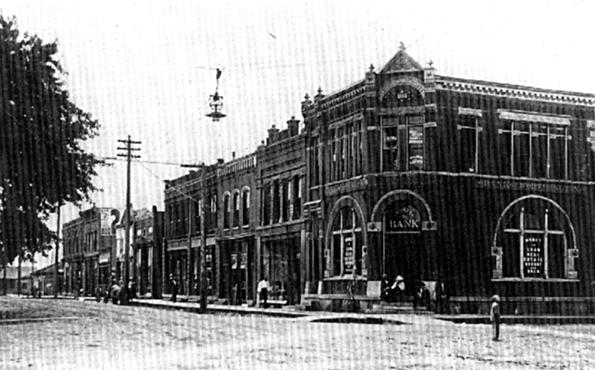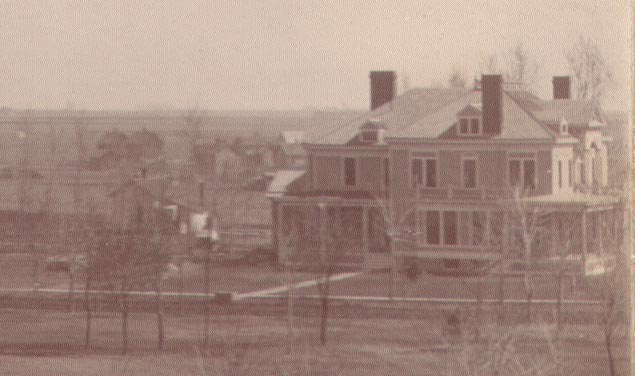Dayton Family History:

George Dayton was born in New York to a family of average means. His dream was to become a minister, but after the economic panic of 1873, his father arranged for his apprenticeship in a nursery, coal and lumber yard. This altered his path toward business rather than the ministry. During his apprenticeship he met his future wife, Emma Chadwick, who would become his greatest supporter. They married in 1878.
Dayton, diligent and savvy in the area of business, learned of investment opportunities in the Midwest and, along with other investors, bought farm mortgages in southwestern Minnesota. Later hearing of continuing problems in Worthington, Dayton was encouraged by eastern investors to travel to the area and in 1883 George moved his family to Worthington.
Worthington was edging toward prosperity at this time, having been devastated by a financial panic and the Spirit Lake Massacre (1850s), the civil war and the U.S. Dakota Conflict (1860s), grasshopper plagues and grassfires (1870s). Pioneers had been reluctant to set up permanent residence until the railroad came through the county and positive signs of agricultural development appeared. Dayton arrived in the village of Worthington during this more promising time and helped to establish Worthington as a thriving community.
The Bank of Worthington, built in 1886.
 Guided by religious principles, George Dayton, president of the Bank of Worthington and founder of the Minnesota Loan and Investment Company, facilitated the commercial and cultural development of the community. His success and prominence allowed him to contribute meaningfully to the social, educational, and religious life of Worthington.
Guided by religious principles, George Dayton, president of the Bank of Worthington and founder of the Minnesota Loan and Investment Company, facilitated the commercial and cultural development of the community. His success and prominence allowed him to contribute meaningfully to the social, educational, and religious life of Worthington.
One of the first advertisements for the Minnesota Loan and Investment Co. that was started by George D. Dayton. (1884)
In 1889, George and Emma welcomed a fourth child into their family. Due to an enlarging family or wanting to support growing areas of the community, George made plans to build a house, his third home since moving to Worthington. In 1890, he hired Sioux Falls architect, Wallace Dow, to design a grand home in a prominent area of town, spanning eight lots.
The new home was noteworthy and described in the local paper, The Worthington Advance:
Worthington Advance 12 June 1890
Work has begun on the new residence of Mr. Geo. D. Dayton, on the lot formerly occupied by him, from which the house was removed to Clary-Addition. The cellar has been excavated and walled up. The foundation will soon be completed. The structure will be an ornament to the village.Mr. Dayton's new residence now displays its massive and elegant proportions, though much has to be done before it is complete. It will be an ornament to the village, and marks a new epoch in our village history, where progress and prosperity is evinced in structures of elegance, taste and comfort. Let others follow in this line.
Worthington Advance 24 July 1890
Mr. Geo. D. Dayton's family moved into their new residence the latter part of last week. This is an important and sightly ornament added to the residence portion of our village, and few cities contain family residences more fitly adapted, or more elegantly adorned, than the new home of Mr. Dayton. The style of the building is up to the requirements of modern taste, the arrangement of the grounds and surroundings is appropriate, and the conveniences of the house are of the most perfect order and character. We welcome this latest acquisition of our town as one which will strike the eye of every new comer favorably; an exhibition of social and financial progress and prosperity, and by no means the last one which our prosperous means will add to the attractions of the place. This good example set, there will be more to follow.
Worthington Advance 16 Oct 1890
Dayton's business ventures enjoyed prosperity, but he seemed to measure success by how much he contributed to raising the level of mankind and by dedicating himself to service. Thus, he delved into projects to improve the community. He served as President of the Worthington Board of Trade, created the Worthington Flour Milling Company, served on committees of the Worthington Home Improvement Association, served on the Worthington Board of Education, and was church clerk, elder, and trustee. He and his wife both taught Sunday school and George was superintendent as well. Emma was equally involved in church activities and often hosted events in the Dayton house.
Westminster Presbyterian Church, dedicated in 1900 while George D. Dayton was President of the Board of Trustees of the school.
Dayton's business ventures eventually led to the purchase of land along Nicollet Avenue in Minneapolis, which would later house the Dayton Department Store. However, the Dayton family remained in their Worthington home until 1902 and must have been quite fond of it, for they had a similar home constructed in Minneapolis (no longer standing).
Dayton's dedication to service continued in Minneapolis and George was thought of as a philanthropist of the nation, not just his local community. After moving away, he continued to donate significant sums of money to his Worthington church. He also established The Dayton Foundation dedicated to promoting the welfare of humankind.
